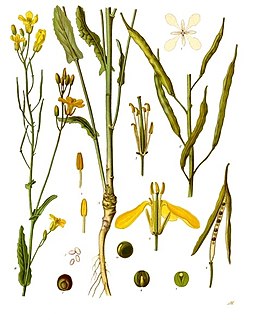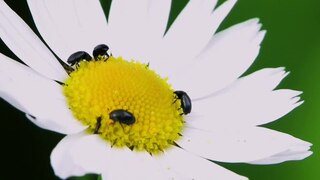
Brassicaceae or Cruciferae is a medium-sized and economically important family of flowering plants commonly known as the mustards, the crucifers, or the cabbage family. Most are herbaceous plants, while some are shrubs. They have simple alternatingly-set leaves, without stipules, or in leaf rosettes. Their inflorescences are terminal and bractless. Their flowers have four free sepals, four free alternating petals, two shorter free stamens and four longer free stamens. Their fruit has seeds in rows, divided by a thin wall.

Brassica is a genus of plants in the cabbage and mustard family (Brassicaceae). The members of the genus are informally known as cruciferous vegetables, cabbages, or mustard plants. Crops from this genus are sometimes called cole crops—derived from the Latin caulis, denoting the stem or stalk of a plant.

Rapeseed, also known as rape, or oilseed rape, is a bright-yellow flowering member of the family Brassicaceae, cultivated mainly for its oil-rich seed, which naturally contains appreciable amounts of erucic acid. Canola are a group of rapeseed cultivars which were bred to have very low levels of erucic acid and are especially prized for use as human and animal food. Rapeseed is the third-largest source of vegetable oil and the second-largest source of protein meal in the world.

The tansy beetle is a species of leaf beetle. It measures 7.7–10.5 mm in length and has a characteristic bright metallic green colouration. The common name derives from the tansy plant on which they often feed as both larvae and adults. In addition to the nominotypical subspecies, which repeats the specific name, C. graminis graminis, there are five further distinct subspecies of tansy beetle, which, collectively, have a Palearctic distribution, although in the majority of countries where it is found the species is declining. In the United Kingdom it is designated as 'Nationally Rare' and this localised population, centred on York, North Yorkshire, has been the subject of much recent research.

Chinese cabbage can refer to two cultivar groups of leaf vegetables often used in Chinese cuisine: the Pekinensis Group and the Chinensis Group.

Brassica rapa is a plant species growing in various widely cultivated forms including the turnip ; napa cabbage, bomdong, bok choy, and rapini; and Brassica rapa subsp. oleifera, an oilseed which has many common names, including turnip rape, field mustard, bird's rape, and keblock.

The flea beetle is a small, jumping beetle of the leaf beetle family (Chrysomelidae), that makes up the tribe Alticini which is part of the subfamily Galerucinae. Historically the flea beetles were classified as their own subfamily.

The diamondback moth, sometimes called the cabbage moth, is a moth species of the family Plutellidae and genus Plutella. The small, grayish-brown moth sometimes has a cream-colored band that forms a diamond along its back. The species may have originated in Europe, South Africa, or the Mediterranean region, but it has now spread worldwide.
Leptosphaeria maculans is a fungal pathogen of the phylum Ascomycota that is the causal agent of blackleg disease on Brassica crops. Its genome has been sequenced, and L. maculans is a well-studied model phytopathogenic fungus. Symptoms of blackleg generally include basal stem cankers, small grey lesions on leaves, and root rot. The major yield loss is due to stem canker. The fungus is dispersed by the wind as ascospores or rain splash in the case of the conidia. L. maculans grows best in wet conditions and a temperature range of 5–20 degrees Celsius. Rotation of crops, removal of stubble, application of fungicide, and crop resistance are all used to manage blackleg. The fungus is an important pathogen of Brassica napus (canola) crops.
Verticillium longisporum, also known as Verticillium Wilt, is a fungal plant pathogen that commonly infects canola. V. longisporum can attack other brassica plants as well as woody ornamentals. A main symptom of the infected plant is wilting. In America, V. longsiporum primarily effects eudicot plants. This pathogen can be very devastating and hard to eradicate, responding only to expensive fumigation or fungal resistant plants.
Aphthona czwalinae is a species of leaf beetle known as the black leafy spurge flea beetle. It is used as an agent of biological pest control against the noxious weed leafy spurge.

Brassica carinata is a species of flowering plant in the Brassicaceae family. It is referred to by the common names Ethiopian rape, Ethiopian mustard. It is believed to be a hybrid between Brassica nigra and Brassica oleracea.

The striped flea beetle is a small flea beetle, shiny black with a greenish tinge, 1.5 to 2.5 mm long, having a wavy amber line running the length of each elytron. It is a pest of cabbage and other brassicas. The hind legs are thickened, enabling the beetle to jump like a flea when disturbed.

Baridinae is a subfamily of true weevils (Curculionidae). It was established by Carl Johan Schönherr in 1836. Some 4,300 species in 550 genera are placed here, most of which occur in the New World. A few are economically significant pests, while others are in turn used for biocontrol of invasive plant pests. This subfamily also contains a few endangered species.

Crocidolomia pavonana is a moth of the family Crambidae. Its caterpillar is a crop pest and is known as the croci or the cabbage cluster caterpillar. This moth is found in Africa and Asia, its range extending from South Africa through India to the Pacific Ocean, including Australia. The wingspan is about 25 mm (1 in). The larvae feed on Brassicaceae species and are considered an agricultural pest on cabbages. At first, they feed only on the undersides of the leaves. Later they feed on the rest of the leaves and the central shoot. The species was first described by Johan Christian Fabricius in 1794.
Psylliodes luridipennis, commonly known as the Lundy cabbage flea beetle or the bronze Lundy cabbage flea beetle, is a species of flea beetle endemic to the island of Lundy, where it lives and feeds upon the endemic Lundy cabbage. Along with the true weevil Ceutorhynchus contractus var. pallipes and an undescribed race of flea beetle Psylliodes napi, it is known only from the Lundy cabbage. The species was first recorded by Thomas Vernon Wollaston in the 1840s, and was named by the Austrian entomologist Franz Kutschera in 1864.

Psylliodes is a large genus of flea beetles in the family Chrysomelidae. There are about 200 described species worldwide.

Phyllobius argentatus is a species of short-nosed weevil commonly known as the silver-green leaf weevil.

Phyllotreta nemorum, the turnip flea beetle or yellow-striped flea beetle is a species of beetle in family Chrysomelidae. It is found in the Palearctic It is a pest of Brassica oleracea, Brassica rapa and Brassica napus.

Brassicogethes aeneus, the common pollen beetle, is a species of pollen beetle in the family Nitidulidae. Other common names include the rape pollen beetle and rape blossom beetle. It was previously known as Meligethes aeneus.



















